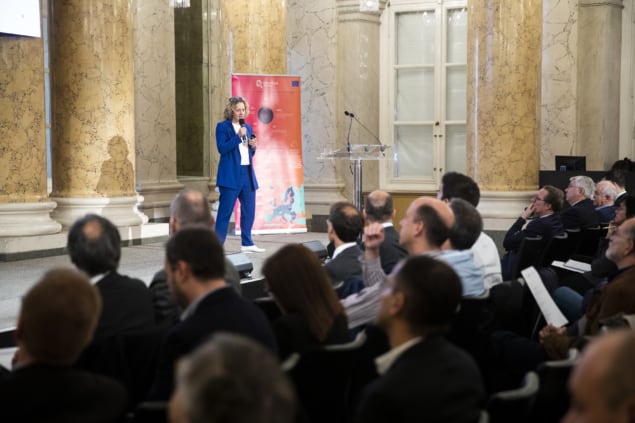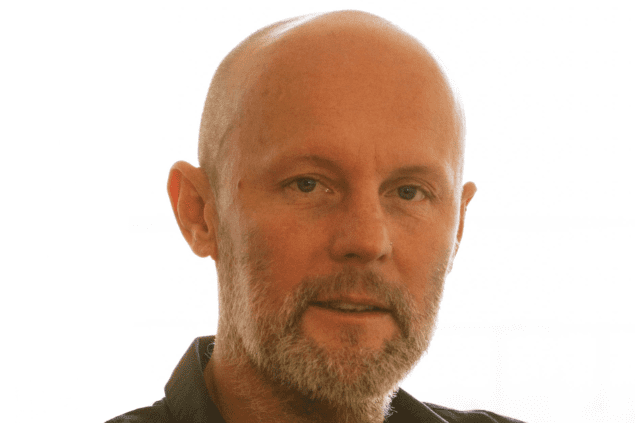Members of Europe’s quantum-science community gathered in Vienna on 29–30 October for the official launch of the Quantum Flagship, a 10-year, €1bn initiative to support R&D on quantum communications, computing, sensing and simulation. Here, three participants – all of them senior figures in the field of quantum communication – share their views about the discipline’s future direction.

Creating a quantum Internet: Stephanie Wehner
Stephanie Wehner is a professor of quantum information at QuTech, Delft University of Technology, Netherlands
You’re the co-ordinator for the Quantum Internet Alliance, which is one of the first projects to be funded by the Quantum Flagship. What are you most excited about in this project?
The prospect that I’m most excited about is advancing technology towards a quantum repeater, so we can send qubits over very long distances. The other thing I’m quite excited about is our goal of linking small quantum processors together, which will allow us to do things that are more complicated than quantum key distribution. For example, we want to run a very elementary secure quantum computation via the cloud.
What are the biggest challenges in building a quantum repeater?
The first thing you want is a very good quantum memory. In a cartoon version of a quantum repeater, you make entanglement between A and B, and also between B and C, and then you perform a sort of “gluing” operation on point B to create end-to-end entanglement between A and C. In order to do this, there is some moment in time when you need to capture both of these qubits, and this is why you need a quantum memory. You also want this quantum memory to be very good and very efficient, because you want to be able to produce entanglement fast, but if your memory doesn’t have the corresponding capabilities, that’s not good. You need the right “quantum link efficiency” between memory and the speed of entanglement generation.
Where do you expect the field to be in 10 years?
That’s a very difficult question – ten years is a long time into the future. But I hope that in 10 years we’re at the point where we can say, okay, we have a quantum repeater – now let’s scale it and use them everywhere. Currently we have quantum links that are point-to-point. The next thing would be to go to a star-shaped configuration, which would allow more people to talk to each other without a direct fibre connection. That would already be very interesting, if we could connect metropolitan areas. The next step after that is to go for very long distances. For quantum communication to become commercially usable on a broad scale you want quantum repeaters so that you can bridge arbitrary distances.

Supporting diverse technologies: Rupert Ursin
Rupert Ursin is the deputy director of the Institute for Quantum Optics and Quantum Information at the Austrian Academy of Sciences in Vienna
What are you most excited about right now?
There’s a lot of new developments going on in quantum communications. But most of it is in physics-oriented experiments; we are not yet in the phase of doing real engineering work. The flagship is, however, so the very first projects that have been selected are trying to avoid risk by doing things we know a lot about already and developing them further. The real new stuff is in semiconductor-type quantum sources for both quantum communication and computation, but that is not funded yet in the flagship. I hope this will improve in the future, because if we just do the “obvious” things, this will not help Europe keep up with the Chinese or the Americans.
Do you think Europe is playing catch-up against China and the US in this field?
The amount of money that is available in Europe is negligible compared to what is available in China, and to keep up with the Chinese is not easy because the decision-making process there is quick and efficient. But I don’t think that trying to avoid risk is the best way to do it. Think about the development of classical computers. In the early 1960s, even the late 1960s, semiconductor-based computers were not the obvious thing to do. So I hope the flagship will fund a plethora of projects in diverse technologies to support all kinds of ideas, because that is of utmost importance. We have to find a way to use the given amount of money in an efficient way.
Where do you expect the field to be in 10 years’ time?
I have to be very clear here: I am a physicist by training and I have no clue about engineering or how to make money out of quantum technologies. I run a spin-off company but it’s my students who are in charge – they are the real economic experts. We physicists tend to find very bad applications for our technology. Quantum cryptography, for example, might not be the best idea, but it’s an idea that the physics community came up with, so…! And the fact that I don’t know, and nobody else should claim that they know either, again shows that we have to look at this field in a much broader way.

Engaging with industry: Rob Thew
Rob Thew is a physicist at the University of Geneva, Switzerland, and leader of the Quantum Flagship Support Action Team’s work package on strategy and structuring
What area of quantum technologies are you most excited about?
Personally, I’m most excited about quantum communications – that’s where I work. But over the whole range of applications, whether it’s computing, sensing, simulation or communication, there seems to be a nice focus on how these things can serve society. Whether it’s quantum sensing for health, quantum communication for securing your medical records, or quantum computation for, potentially, developing new drugs, there’s a nice trend towards taking technology out of the lab and making it into applications.
What has surprised you most about recent developments in the field?
The engagement from industry. I’ve been talking to people in industry for the last 10 years trying to get them interested, but there’s been a real shift in the last few years towards a belief that this technology is sufficiently mature. That has helped bring engineering into the labs and made the rate of technological progress much faster. Academia is historically where a lot of the blue-sky thinking takes place, bringing new ideas to the table and making devices that function. What industry adds to that is to make devices that function not just once or twice, to get a nice scientific publication, but are truly robust in the sense that they can just be turned on and operated by someone who knows nothing about quantum physics.
Where do you hope this field will be in 10 years’ time?
I’d like to look back and think we were a bit crazy, maybe, and a little too optimistic – but not much. I’d like to see us really succeed in developing a lot of these technologies, so that we’re not talking about what the Quantum Flagship did, but what we’re going to do next.



